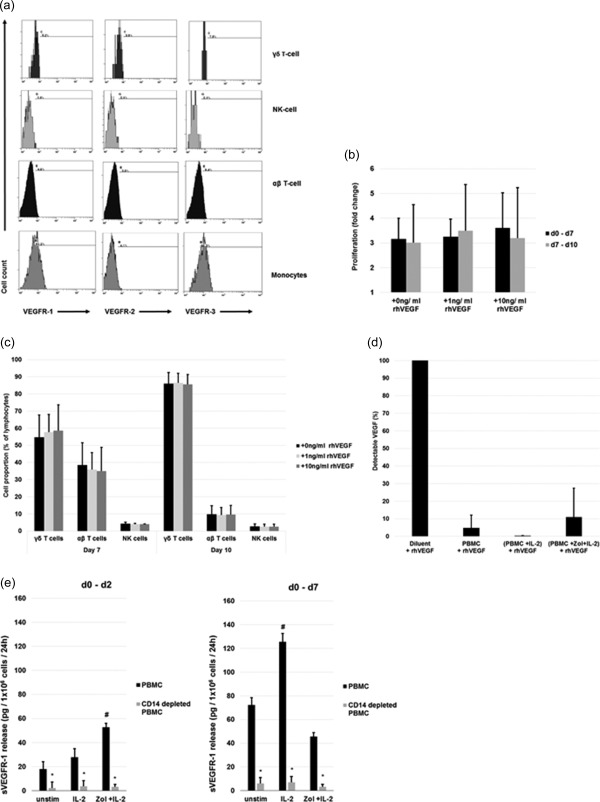Figure 2.

Expression, function and interference of vascular endothelial growth factor receptors (VEGFRs) on peripheral blood mononuclear cells (PBMCs). (a) Flow cytometry analysis of VEGFR‐1, −2 and −3 expression on freshly isolated, unstimulated PBMCs gated on different subpopulations. Positivity is defined according to the isotype antibody control staining. (b,c) Effect of recombinant human VEGF (rhVEGF) on proliferation of stimulated PBMCs. Different concentrations of rhVEGF were added to a culture of zoledronic acid (Zol) + interleukin (IL)‐2 stimulated PBMCs on days 0 or 7. (b) Proliferation of cells between days 0–7 (rhVEGF added on day 0) and days 7–10 (rhVEGF added on day 7) as fold change from initial cell count. (c) γδ T cell, αβ T cells and natural killer (NK) cells as a fraction of the gated lymphocytes after 7 days (rhVEGF added on day 0) and 10 days (rhVEGF added on day 7) of culture. (d) Soluble factors interfere with detection of VEGF. Detectable free VEGF by enzyme‐linked immunosorbent assay (ELISA) after spiking of 400 pg/ml rhVEGF into the supernatants of differently stimulated PBMCs compared to spiking the same amount into calibrator diluent. (e) Quantification of sVEGFR‐1 in cell culture supernatants of differently stimulated PBMCs, with or without prior depletion of CD14+ cells. Soluble VEGFR (sVEGFR)‐1 release/106 cells/24 h between days 0–2 and 0–7 was measured at the end of the respective interval in the supernatants by ELISA and normalized with regard to cell count and culture time. Shown are the results from three different treatment regimens: (1) unstimulated, (2) IL‐2 (IL‐2 100 U/ml added on day 0), (3) Zol + IL‐2 (1 µM Zol and IL‐2 100 U/ml added on day 0). All data are either presented as a representative example of at least three independent experiments (Fig. 2a) or depicted as mean ± standard deviation (s.d.) of at least three independent experiments. *P < 0·05 compared to undepleted PBMCs, # P < 0·05 compared to unstimulated control.
